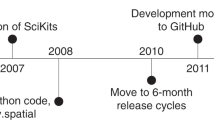
Overview
- Programming concepts are always introduced in well-known mathematical contexts- Numerical algorithms and applications are used as examples, rather than as main topics
- Surveys and compares many different languages
- Didactically, concepts once understood, are then carried over to various other languages - helpful for mathematicians and practitioners who are trying to decide which programming language to use for which purposes
Part of the book series: Texts in Computational Science and Engineering (TCSE, volume 25)
Access this book
Tax calculation will be finalised at checkout
Other ways to access
About this book
The book provides an introduction to common programming tools and methods in numerical mathematics and scientific computing. Unlike widely used standard approaches, it does not focus on any particular language but aims to explain the key underlying concepts.
In general, new concepts are first introduced in the particularly user-friendly Python language and then transferred and expanded in various scientific programming environments from C / C ++, Julia and MATLAB to Maple. This includes different approaches to distributed computing.
The fact that different languages are studied and compared also makes the book useful for mathematicians and practitioners trying to decide which programming language to use for which purposes.
Similar content being viewed by others
Keywords
Table of contents (14 chapters)
-
Front Matter
-
Background
-
Front Matter
-
-
Core Languages
-
Front Matter
-
-
Distributed Computing
-
Front Matter
-
-
Specialized Programming Environments
-
Front Matter
-
Authors and Affiliations
About the author
He has published a textbook on Mathematical Computability Theory, and a biography of the German computer scientist C.A. Petri. Both books have been published by Springer. In recent years he has mainly been concerned with the teaching of numerical methods at the University of Bonn, with an emphasis on computer programming.
Bibliographic Information
Book Title: Introduction to the Tools of Scientific Computing
Authors: Einar Smith
Series Title: Texts in Computational Science and Engineering
DOI: https://doi.org/10.1007/978-3-030-60808-8
Publisher: Springer Cham
eBook Packages: Computer Science, Computer Science (R0)
Copyright Information: Springer Nature Switzerland AG 2020
Softcover ISBN: 978-3-030-60810-1Published: 04 December 2021
eBook ISBN: 978-3-030-60808-8Published: 02 December 2020
Series ISSN: 1611-0994
Series E-ISSN: 2197-179X
Edition Number: 1
Number of Pages: XII, 344
Number of Illustrations: 7 b/w illustrations, 33 illustrations in colour
Topics: Computational Mathematics and Numerical Analysis, Mathematics of Computing



